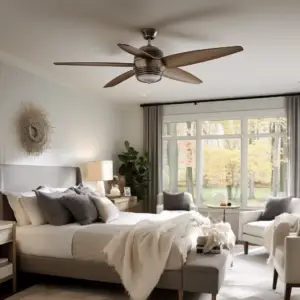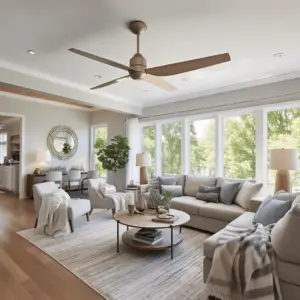Ceiling Fan Direction is the easiest way to keep your house cool? If you’re like most people, you turn on the AC and maybe open a window or two.
But there’s another common way to bring the breeze: Ceiling fans. They are considered the most effective means of keeping things comfortable without adding up to your utility bill.
However, as beneficial as they can be, ceiling fans are not without their faults. You may encounter many issues such as humming noise, flickering light, or fan changing direction by itself.
So if you’re having problems with your fan’s functioning in an expected way, check out these troubleshooting tips to pinpoint the problem and have it fixed.
Table of Contents
What Makes Ceiling Fans Change Direction?

Most of the ceiling fans are capacitor start induction run motors. That means the direction of the current in the start winding dictates the direction that the motor turns.
Reversing the capacitor definitely reverses the direction of the fun. So if the motor of your fan is having trouble keeping up with the rotating induction, it could start spinning in the opposite direction.
Ceiling Fan Direction important to check whether a dimmer switch is designed for motor control only, fluorescent lighting only or a modern led compatible dimmer switch.
Note that you cannot control the light and the motor with just one dimmer, and consequently, can’t use a dimmer at all if the wire isn’t three-wire cables feeding the ceiling fan.
The dimmers typically have semiconductors in them or some other components that may affect the motor and potentially change the fan’s direction of rotation.
That being said, it’s generally hard for a ceiling to reverse itself without a switch being thrown. It is supposed to go one way in the summer and the other way in the winter.
So, check whether you flipped the switch by accident without knowing, for instance, when cleaning.
What Happens If a Fan Rotates In the Opposite Direction?
When the fan operates in reverse, it draws air upward. Most people see this as a way of drawing the warmer air near the ceiling back down into the lower half of the room. The use of the reverse function is generally common in the winter.
Still, that’s not the only way to use it. In the event that your air conditioning vents are near the floor, then running the fan in reverse can draw the cool air upward and circulate it around the room, so that you can actually feel it.
Ceiling Fan Direction can therefore help to maximize the effectiveness of your AC, which in turn, will allow you to keep it at a lower setting.
The reverse direction can also blow warm air out of high windows, creating opposite air pressure that will draw in cooler air from lower windows.
In some cases, it’s possible to fan warm air out on the hot side of the room and draw cooler air in the side that doesn’t receive direct sunlight.
Before turning on a ceiling fan, take some time to consider what it is supposed to bring. Do you want to blow air onto your skin so that you will cool down? Or do you want to draw cool air upward so that the warm air circulates back into the space you’re enjoying?
Sometimes you may also want to draw in outdoor air to push indoor air out an open window. So, it’s important to give it some thought and be conscious about operating your ceiling fans rather than cranking up the heater or AC.
Ceiling Fan Standard Operation
Perhaps the best time to use your fan is when you need air to cool your skin on a hot day. You can draw fresh air indoors from transom windows, operable skylights, and even tops of double-hung windows. The fan can help keep the air in the space near the floor cooler and fresher.
Operate Your Fan Counterclockwise in the Summer
The blades of your fans should be rotating counterclockwise in the summer. This will allow the angled blades to move air downward. This direction creates a wind chill effect that makes you feel cooler than the actual room temperature.
Your ceiling fan can help you decrease your summer energy bills if it is rotating in the appropriate direction.
How to Reverse the Direction of Your Ceiling Fan

In case your ceiling fan is spinning in the wrong direction, you can easily reverse it. First, turn off the fan and make sure it has come to a complete stop. Then, for most brands, changing direction is as simple as flipping the switch located directly on the side of the fan.
So grab a step stool and locate the direction switch. Flip it in the opposite direction and then power the fan back on, beginning with a lower speed to check that the blades are moving in the opposite direction.
If your ceiling fan is an older model and doesn’t have a switch, then simply adjust the blade switch. You can do this by tilting the blade to the right to push the air down, and tilting it in the opposite direction to pull air upwards.
With newer ceiling fans, however, you might have to use the included remote control to reverse the direction. Some other models have wall switches to control them.
How to Change from Counterclockwise to Clockwise
During the summer months, your ceiling fan should be running forward in a counterclockwise direction. Fans are generally to run this way to push cool air downwards and bring you relief from the warm temperature.
However, in the winter, keeping the direction of your ceiling fan in this motion (clockwise) will cool you down even further, which is something you surely want to avoid, especially when it’s freezing outside.
So remember to reverse the direction of your fans during winter, so the blades of the fans draw cool air from below and push it upwards. This also helps to force the warm air near the ceiling down the floor where people are.
Once you’ve got your cooling appliance running in the direction, the next decision is speed. Well, this is largely personal taste. The warmer the temperature in your room, the faster you may need to set your ceiling fan to help feel cooler and refreshed. That said, high speed can get unbearable for some people.
